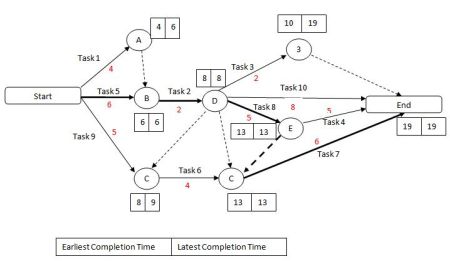Critical Path Method
Critical Path Method
Introduction
If you have been into project management, I'm sure you have already heard the term 'critical path method.'
If you are new to the subject, it is best to start with understanding the 'critical path' and then move on to the 'critical path method.'
Critical path is the sequential activities from start to the end of a project. Although many projects have only one critical path, some projects may have more than one critical paths depending on the flow logic used in the project.
If there is a delay in any of the activities under the critical path, there will be a delay of the project deliverables.
Most of the times, if such delay is occurred, project acceleration or re-sequencing is done in order to achieve the deadlines.
Critical path method is based on mathematical calculations and it is used for scheduling project activities. This method was first introduced in 1950s as a joint venture between Remington Rand Corporation and DuPont Corporation.
The initial critical path method was used for managing plant maintenance projects. Although the original method was developed for construction work, this method can be used for any project where there are interdependent activities.
In the critical path method, the critical activities of a program or a project are identified. These are the activities that have a direct impact on the completion date of the project.

Key Steps in Critical Path Method
Let's have a look at how critical path method is used in practice. The process of using critical path method in project planning phase has six steps.
Step 1: Activity specification
You can use the Work Breakdown Structure (WBS) to identify the activities involved in the project. This is the main input for the critical path method.
In activity specification, only the higher-level activities are selected for critical path method.
When detailed activities are used, the critical path method may become too complex to manage and maintain.
Step 2: Activity sequence establishment
In this step, the correct activity sequence is established. For that, you need to ask three questions for each task of your list.
-
Which tasks should take place before this task happens.
-
Which tasks should be completed at the same time as this task.
-
Which tasks should happen immediately after this task.
Which tasks should take place before this task happens.
Which tasks should be completed at the same time as this task.
Which tasks should happen immediately after this task.
Step 3: Network diagram
Once the activity sequence is correctly identified, the network diagram can be drawn (refer to the sample diagram above).
Although the early diagrams were drawn on paper, there are a number of computer softwares, such as Primavera, for this purpose nowadays.
Step 4: Estimates for each activity
This could be a direct input from the WBS based estimation sheet. Most of the companies use 3-point estimation method or COCOMO based (function points based) estimation methods for tasks estimation.
You can use such estimation information for this step of the process.
Step 5: Identification of the critical path
For this, you need to determine four parameters of each activity of the network.
-
Earliest start time (ES) - The earliest time an activity can start once the previous dependent activities are over.
-
Earliest finish time (EF) - ES + activity duration.
-
Latest finish time (LF) - The latest time an activity can finish without delaying the project.
-
Latest start time (LS) - LF - activity duration.
The float time for an activity is the time between the earliest (ES) and the latest (LS) start time or between the earliest (EF) and latest (LF) finish times.
During the float time, an activity can be delayed without delaying the project finish date.
The critical path is the longest path of the network diagram. The activities in the critical path have an effect on the deadline of the project. If an activity of this path is delayed, the project will be delayed.
In case if the project management needs to accelerate the project, the times for critical path activities should be reduced.
Earliest start time (ES) - The earliest time an activity can start once the previous dependent activities are over.
Earliest finish time (EF) - ES + activity duration.
Latest finish time (LF) - The latest time an activity can finish without delaying the project.
Latest start time (LS) - LF - activity duration.
Step 6: Critical path diagram to show project progresses
Critical path diagram is a live artefact. Therefore, this diagram should be updated with actual values once the task is completed.
This gives more realistic figure for the deadline and the project management can know whether they are on track regarding the deliverables.
Advantages of Critical Path Method
Following are advantages of critical path methods:
-
Offers a visual representation of the project activities.
-
Presents the time to complete the tasks and the overall project.
-
Tracking of critical activities.
Offers a visual representation of the project activities.
Presents the time to complete the tasks and the overall project.
Tracking of critical activities.

0 Comments:
Post a Comment
Subscribe to Post Comments [Atom]
<< Home